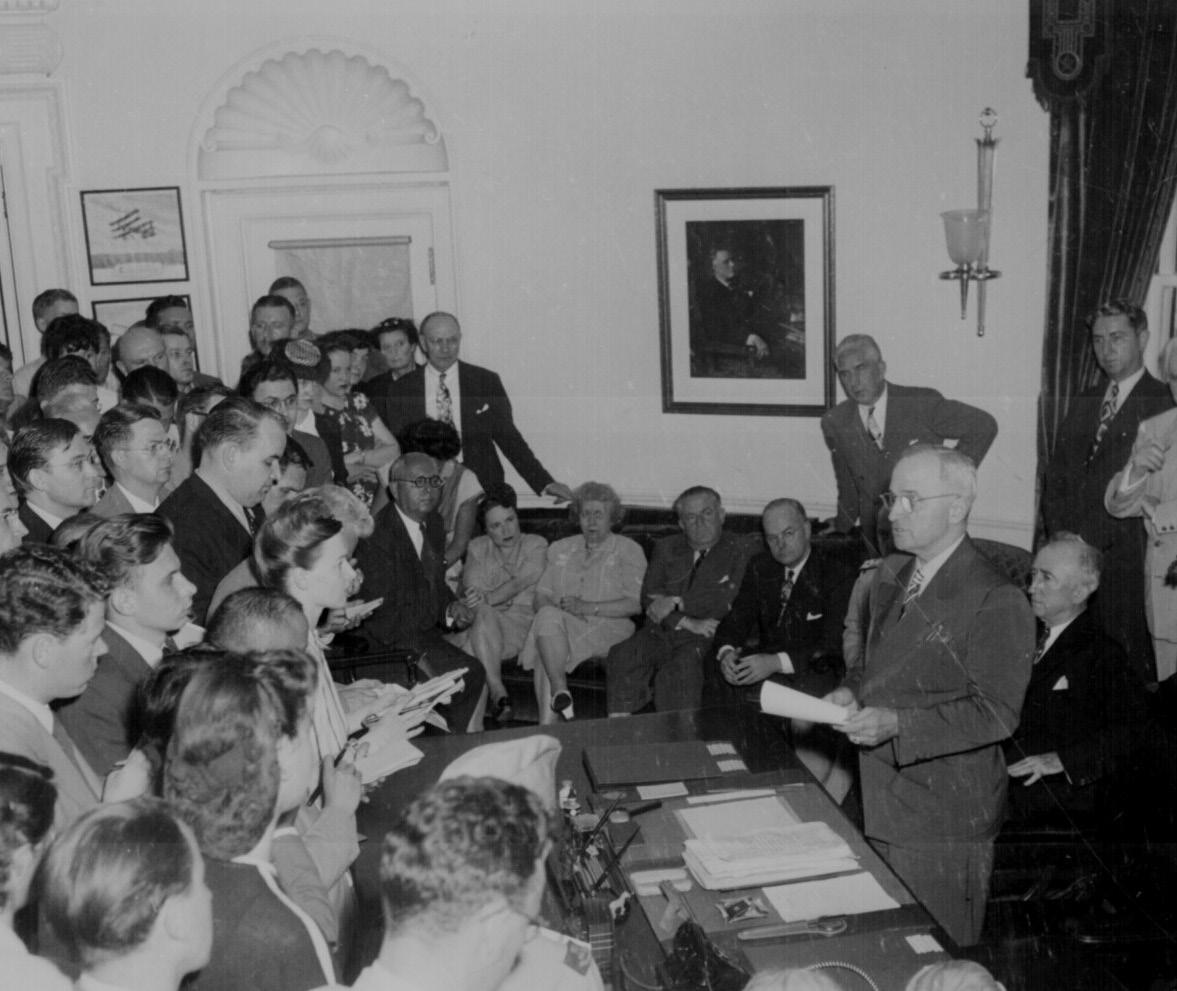
4 minute read
Then Largest party in Downtown History
The 75th anniversary of the night Chicagoans celebrated the end of World War II
by Stella Kapetan
Chicagoans in August 1945 were eagerly awaiting official news of the Japanese surrender to the Allies that news outlets had been reporting for weeks was imminent and would end World War II. People were weary of the war that had begun more than three years earlier when the Japanese attacked Pearl Harbor on Dec. 7, 1941. More than 11,000 servicemen and women from Cook County and 400,000 nationwide were dead, according to the Pritzker Military Museum and Library. The average Chicago block had seven of its own in the service. Finally, on Tuesday, August 14 at 6 p.m. CT, President Truman announced the surrender. “No force on earth could stop what happened then,” the Sun newspaper reported at the time. Within minutes 10,000 Loop workers poured out of office buildings, restaurants and hotels and flooded the sidewalks and streets, the Chicago Tribune wrote. Thousands more who were headed home after work turned around and went back. Others from the city, suburbs and surrounding area hopped onto trains and streetcars and into their cars and rushed down to join the festivities, while factories that were involved in wartime production sent busloads of their employees.
It was natural for people to gravitate to downtown to celebrate what is known as V-J Day, Perry Duis and Scott LaFrance wrote in their book, “We’ve Got a Job to Do, Chicagoans and World War II.” It had been the scene of military parades, rallies, outdoor prayer services and other emotional events the government staged throughout the war to boost and sustain morale.
While the celebration occurred throughout downtown, the center was State and Madison streets. The Daily News reported that by 8 p.m., “In a four block area bounded by Madison, Clark, Randolph and State sts. police estimated a million persons were poking each other with elbows and shouting into everybody’s ears. Nobody apologized. Nobody wanted an apology.” And more were on their way. The party lasted well past midnight. And it was loud.
Revelers of all ages, from adolescents to the elderly, cheered, sang, danced and jittberbugged in the streets accompanied by drums, noisemakers, clackers and tin horns under a blizzard of wastepaper, confetti, ticker tape and bags of water that fell from office building windows. Five sailors and three nurse cadets started a conga line at State and Madison streets. Several hundred people joined them until the line stretched for several blocks. Also on State Street, two women who had managed to find large drums led a two-block long parade. Firecrackers popped and “dishpans and spoons became musical instruments,” the Daily News reported.
Meanwhile, there were other spontaneous expressions of joy. Servicemen kissed women. And women kissed servicemen, leaving them with lipstick smeared faces.
While many streets were officially closed to traffic, others were effectively shut down by the crowds. Trapped drivers joined in the fun by honking their horns. The Chicago Tribune reported that by 8 p.m., “Some of the traffic policemen gave up and went into restaurants,” while others were swept up by the crowds.
Over on Madison Street, just west of State Street, the fire department responded to a false alarm at the McVickers Theater. “When the truck moved away, a score of spectators were clinging to it," the Daily News reported.
Bar owners had agreed that they would close their businesses as soon as the surrender was announced in anticipation of the rowdy crowd. “But there was an abundance of liquor in bottle dimensions” the Daily News reported. “It was better than going to a saloon and cheaper. Anybody who wanted a drink could get it from the guy jostling him. Service was swell. Some of those with bottles had brought along paper cups.” Sailors on Randolph Street put their bottles of beer to good use by extinguishing a car fire.
Despite the throngs and free flowing liquor, “It was a carnival of clean fun,” Chief John Prendergast of the uniformed police told the Daily News. The estimated 800 policemen had little to do “except look on and smile at the celebrants,” the Chicago Herald American reported. Trolley car wires were disconnected from overhead wires "but the motormen and conductors didn’t seem to mind,” according to the Daily News. The seven first aid stations set up to treat minor injuries saw few people. And the Red Cross treated 200 people for fainting, minor injuries and heart attacks by 11:30 p.m. the Chicago Tribune wrote.
At dawn, the last of the partygoers staggered home, and city workers started clearing the debris from the streets.
In the weeks leading up to V-J Day, while Chicagoans knew the war’s end was near, many feared there would be a return to Depression era unemployment with the expected elimination of thousands of war-related jobs. But while they were celebrating on that August night 75 years ago, the only thing that seemed to be on their minds was that their loved ones away at war - many for years - were coming home.

LEFT TOP: At the White House, President Truman announces Japan's surrender. Abbie Rowe, Washington, DC, August 14, 1945 .

LEFT BOTTOM: Gen. Douglas MacArthur signs as Supreme Allied Commander during formal surrender ceremonies on the USS MISSOURI in Tokyo Bay. Behind Gen. MacArthur are Lt. Gen. Jonathan Wainwright and Lt. Gen. A. E. Percival. Although some of the Japanese were attired formally, in tails and top hats, MacArthur specified daily service dress for the Americans, reportedly saying, "We fought them in our khaki uniforms and we'll accept their surrender in our khaki uniforms." Lt. C. F. Wheeler, September 2, 1945.
Both photos courtesy of the National Archives.










